Sultanate of Gowa
Sultanate of Gowa (sometimes written as Goa; not to be confused with Goa in India) was one of the great kingdoms and the most successful kingdom in the South Sulawesi region. People of this kingdom come from the Makassar tribe who lived in the south end and the west coast of southern Sulawesi.
Sultanate of Gowa | |||||||||||
|---|---|---|---|---|---|---|---|---|---|---|---|
| 14th century–1945 | |||||||||||
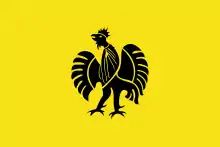 Flag | |||||||||||
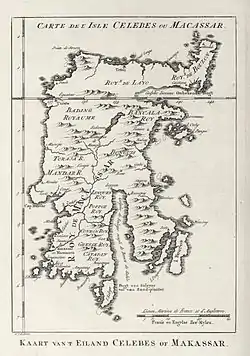 | |||||||||||
| Status | Part of Indonesia | ||||||||||
| Capital | Sungguminasa | ||||||||||
| Common languages | Makassarese | ||||||||||
| Religion | Sunni Islam | ||||||||||
| Government | Monarchy | ||||||||||
| Sultan | |||||||||||
• 1300 | Tumanurung | ||||||||||
• 1653-1669 | Sultan Hasanuddin Tuminanga ri Balla'pangkana | ||||||||||
• 1946-1978 | Sultan Muhammad Abdul Kadir Aiduddin | ||||||||||
• 2014-Present | Sultan Kumala Idjo Batara Gowa | ||||||||||
| History | |||||||||||
• Established | 14th century | ||||||||||
• Dissolution of Sultanate | 1945 | ||||||||||
| Currency | No official currency, the Barter system was used | ||||||||||
| |||||||||||
| Today part of | (as Gowa Regency) | ||||||||||

Part of a series on the |
|---|
| History of Indonesia |
  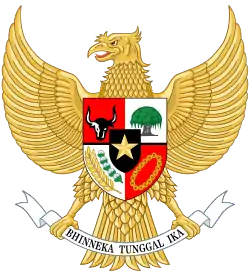 |
| Timeline |
|
|
History
Before the establishment of the kingdom, the region had been known as Makassar and its people as Suku Makassar (tribe of Makassar).[1] The history of the kingdom can be divided into two eras: pre-Islamic kingdom and post-Islamic sultanate.
Pre-Islamic Kingdom
According to the epic poem The Nagarakretagama, in praise of King Rajasanagara of Majapahit, it lists Makassar as one of the kingdom's tributaries in 1365.[2]
The first queen of Gowa was Tomanurung Baine.[1] There is not much known about the exact time when the kingdom was established nor about the first queen, and only during the ruling of the 6th king, Tonatangka Kopi, local sources have noted about the division of the kingdom into two new kingdoms led by two Kopi's sons: Kingdom of Gowa led by Batara Gowa as its 7th king covering areas of Paccelekang, Pattalasang, Bontomanai Ilau, Bontomanai 'Iraya, Tombolo and Mangasa while the other son, Karaeng Loe ri Sero, led a new kingdom called Tallo which includes areas of Saumata, Pannampu, Moncong Loe, and Parang Loe.[1]
For years both kingdoms were involved in wars until the kingdom of Tallo was defeated. During the reign of King of Gowa X, I Manriwagau Daeng Bonto Karaeng Lakiung Tunipalangga Ulaweng (1512-1546), the two kingdoms were reunified to become twin kingdoms under a deal called Rua Kareng se're ata (dual kings, single people in Makassarese) and enforced with a binding treaty.[1] Since then, when someone becomes a king of Tallo, he also becomes the king of Gowa. Many historians then simply call these Gowa-Tallo twin kingdoms as Makassar or just Gowa.[1]
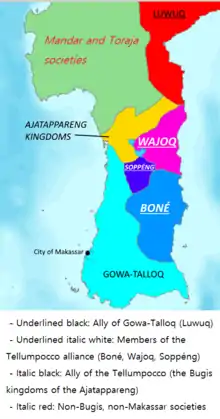
Islamic Sultanate
The traces of Islam in South Sulawesi existed since the 1320s with the arrival of the first Sayyid in South Sulawesi, namely Sayyid Jamaluddin al-Akbar Al-Husaini, who is the grandfather of Wali Songo.[3]
The conversion of the kingdom to Islam is dated as September 22, 1605 when the 14th king of Tallo-Gowa kingdom, Karaeng Matowaya Tumamenaga Ri Agamanna, converted to Islam,[4] where later changed his name to Sultan Alauddin. He ruled the kingdom from 1591 to 1629. His conversion to Islam is associated with the arrival of three ulama from Minangkabau: Datuk Ri Bandang, Datuk Ri Tiro and Datuk Ri Pattimang.
From 1630 until the early twentieth century, Gowa's political leaders and Islamic functionaries were both recruited from the ranks of the nobility.[4] Since 1607, sultans of Makassar established a policy of welcoming all foreign traders.[2] In 1613, an English factory built in Makassar. This began the hostilities of English-Dutch against Makassar.[2]
The most famous Sultan of the kingdom was Sultan Hasanuddin, who from 1666 to 1669 started a war known as Makassar War against the Dutch East India Company (VOC) which was assisted by the prince of Bone kingdom of Bugis dynasty, Arung Palakka.[5]
Dissolution of Sultanate
Since 1673 the area around Fort Rotterdam grew into a city currently known as Makassar.[6] Since 1904 the Dutch colonial government had engaged in the South Sulawesi expedition and started war against small kingdoms in South Sulawesi, including Gowa. In 1911 the Sultanate lost its independence after losing the war and became one of the Dutch Indies' regencies.[7] Following the Indonesian Independence from Netherlands in 1945, the sultanate dissolved and has since become part of the Republic of Indonesia and the former region becomes part of Gowa Regency.
Makassar War

In 1644, Bone rose up against Gowa. The Battle of Passempe saw Bone defeated and a regent heading an Islamic religious council installed. In 1660 Arung Palakka, the long haired prince of the Sultanate of Bonu,[8] led a Bugis revolt against Gowa, but failed.[2]
In 1666, under the command of Admiral Cornelis Speelman, The Dutch East India Company (VOC) attempted to bring the small kingdoms in the North under their control, but did not manage to subdue the Sultanate of Gowa. After Sultan Hasanuddin ascended to the throne as the 16th sultan of Gowa, he tried to combine the power of the small kingdoms in eastern Indonesia to fight the VOC.
On the morning of 24 November 1666, the VOC expedition and the Eastern Quarters set sail under the command of Speelman. The fleet consisted of the admiralship Tertholen, and twenty other vessels carrying some 1860 people, among them 818 Dutch sailors, 578 Dutch soldiers, and 395 native troops from Ambon under Captain Joncker and from Bugis under Arung Palakka and Arung Belo Tosa'deng.[9] Speelman also accepted Sultan Ternate's offer to contribute a number of his war canoes for the war against Gowa. A week after June 19, 1667 Speelman's armada set sail toward Sulawesi and Makassar from Butung.[9] When the fleet reached the Sulawesi coast, Speelman received news of the abortive Bugis uprising in Bone in May and of the disappearance of Arung Palakka during the crossing from the island of Kambaena.
The war later broke in 1666 between the VOC and the sultanate of Gowa.[10] The war continued until 1669, after the VOC had landed its strengthened troops in a desperate and ultimately weakening Gowa. On 18 November 1667 the Treaty of Bungaya was signed by the major belligerents in a premature attempt to end the war.[9]
Feeling aggrieved, Hasanuddin started the war again. Finally, the VOC requested assistance for additional troops from Batavia. Battles broke out again in various places with Sultan Hasanuddin giving fierce resistance. Military reinforcements sent from Batavia strengthened the VOC's military capability, allowing it to break the Sultanate of Gowa's strongest fortress in Somba Opu on June 12, 1669 which finally marked the end of the war. Sultan Hasanuddin resigned from the royal throne, dying on June 12, 1670.
After the Makassar war, Admiral Cornelis Speelman destroyed the large fortress in Somba Opu, and built up Fort Rotterdam (Speelman named this fortress after his birthplace in Netherlands) in its place as the headquarters of VOC activities in Sulawesi. In 1672 Arung Palakka was raised to the throne to become the sultan of Bone.
The war is considered the greatest war the VOC had ever had.
Government
Political administration
The variety of titles used by leaders of small polities is bewildering: anrongguru, dampang, gallarrang, jannang, kare, kasuiang, lao, loqmoq, todo, and more besides. All were local titles Makassarese used before the rise of Gowa. Gowa's expansion brought some systematic order to this variety.[11]:113
Granting titles was an important method of establishing and recognizing a given person/s and a given community's place within society. Ideally, but not always in fact, this hierarchy of titles corresponded to the natural hierarchy of the white blood that the nobles possessed. Distinguishing nobles from commoners, for example, was the right to have a royal or daeng name as well as a personal name. Distinguishing lower ranking nobles such as anaq ceraq from higher-ranking nobles like anaq tiqno was the latter's right to a karaeng title. Granted by the ruler of Gowa, karaeng titles not only signified the bearer's accepted high status, but were often toponyms that gace the bearer the right to demand tribute and labour from the community of that name.[11]:113
Offices did become the domain of the nobles with karaeng titles. The most important of these was Tumabicarabutta, whose task it is was to assist the ruler of Gowa as regent and chief advisor. This pattern of the ruler of Talloq advising the ruler of Gowa became the norm in the first part of the 17th century.[11]:112
Another important office was Tumailalang (literally, “the person on the inside”), the trio of ministers. From the title it appears that the Tumailalang were inchange of managing everyday affairs within Gowa, there was a join tumailalang-sabannaraq office during the reign of Tumapaqsiriq Kallonna. During the subsequent reign, Tunipalannga separated these offices and by the reign of Tunijalloq, there were 2 Tumailalang, later known as the elder tumailalang toa and the younger tumailalang lolo. All holders of the Tumailalang posts were high-rangking karaengs.[11]:112
List of rulers
Islamic period of Gowa started during the reign of I Mangari Daeng Manrabbia Sultan Alau'ddin in 1605.[12]:839
| No | Monarch | Lifetime | Reign |
|---|---|---|---|
| 1 | Tumanurung Baine | Mid-14th century | |
| 2 | Tumassalangga Baraya | ||
| 3 | I Puang Lowe Lembang | ||
| 4 | I Tuniatabanri | ||
| 5 | Karampang ri Gowa | ||
| 6 | Tunatangka Lopi | ||
| 7 | Batara Gowa, titled Tumenanga ri Paralakkenna | ||
| 8 | Pakere Tau Tunijallo ri Passukki | Late 1510 - early 1511 | |
| 9 | Daeng Matanre Karaeng Tumapa'risi' Kallonna | Late 1510/early 1511 - late 1546 | |
| 10 | I Manriwagau Daeng Bonto Karaeng Lakiung Tunipalangga Ulaweng | 1511 - 1565 | 1546 - 1565 |
| 11 | I Tajibarani Daeng Marompa Karaeng Data Tunibatte | 1517 - 1565 | 1565 (only 40 days) |
| 12 | I Manggorai Daeng Mameta Karaeng Bontolangkasa Tunikallo | 1545 - late 1590 | |
| 13 | I Tepukaraeng Daeng Parabbung Tuni Pasulu (deposed) | 1593 - ? | |
| 14 | I Mangari Daeng Manrabbia Sultan Alau'ddin, titled Tumenanga ri Gaukanna | 1586 - 15 June 1639 | 1593 - 15 June 1639 |
| 15 | Tumamenang ri Papambatuna Sultan Malikussaid (Muhammad Said), titled Karaeng Ujung, Karaeng Lakiung | 11 Dec 1607 - 5 Nov 1653 | 1639 - 5 Nov 1653 |
| 16 | I Mallombassi Daeng Mattawang Karaeng Lakiyung Bonto Mangape Sultan Hasanuddin, titled Tuminanga ri Ballaq Pangkana | 12 Jan 1631 - 12 June 1670 | 1653 - 17 June 1669 |
| 17 | Sultan Amir Hamzah, titled Tuminang ri Alluq | 31 Mar 1657-7 May 1681 | 1669 - 1674 |
| 18 | Sultan Muhammad Ali (Karaeng Bisei), titled Tumenanga ri Jakattara | 29 Nov 1654-15 Aug 1681 | 1674 - 1677 |
| 19 | I Mappadulu Daeng Mattimung Karaeng Sanrobone Sultan Abdul Jalil, titled Tuminanga ri Lakiyung | 1677 - 1709 | |
| 20 | La Pareppa Tosappe Wali Sultan Ismail, titled Tuminanga ri Somba Opu | 1709 - 1711 | |
| 21 | I Mappauraqngi Sultan Sirajuddin, titled Tuminang ri Pasi | 1711 - | |
| 22 | I Manrabbia Sultan Najamuddin | ||
| 23 | I Mappaurangi Sultan Sirajuddin, titled Tuminang ri Pasi (second time) | 1735 - 1735 | |
| 24 | I Mallawagau Sultan Abdul Khair | 1735 - 1742 | |
| 25 | I Maappibabasa Sultan Abdul Kudus | 1742 - 1753 | |
| 26 | Amas Madina Batara Gowa (exiled to Srilangka) | 1747-1795 | 1753 - 1767 |
| 27 | I Mallisujawa Daeng Riboko Arungmampu, titled Tuminanga ri Tompobalang | 1767 - 1769 | |
| 28 | I Temmassongeng Karaeng Katanka Sultan Zainuddin, titled Tuminanga ri Mattanging | 1770 - 1778 | |
| 29 | I Manawari Karaeng Bontolangkasa | 1778 - 1810 | |
| 30 | I Mappatunru/I Mangikarang Karaeng Lembang Parang, titled Tuminanga ri Katangka | 1816 - 1825 | |
| 31 | La Oddanriu Karaeng Katangka, titled Tuminanga ri Suangga | 1825 - 1826 | |
| 32 | I Kumala Karaeng Lembang Perang Sultan Abdul Kadir Moh Aidid, titled Tuminaga ri Kakuasanna | d. on 30 January 1893 | 1826 - 30 Jan 1893 |
| 33 | I Malingkaan Daeng Nyonri Karaeng Katangka Sultan Idris, titled Tuminanga ri Kalabbiranna | d. 18 May 1895 | 1893 - 18 May 1895 |
| 34 | I Makkulau Daeng Serang Karaeng Lembangparang Sultan Husain, titled Tuminang ri Bundu'na | 18 May 1895 - 13 April 1906 | |
| 35 | I Mangimangi Daeng Matutu Karaeng Bonto Nompo Sultan Muhammad Tahur Muhibuddin, titled Tuminanga ri Sungguminasa | 1936 - 1946 | |
| 36 | Andi Ijo Daeng Mattawang Karaeng Lalolang Sultan Muhammad Abdul Kadir Aiduddin | d. 1978 | 1956 - 1960 |
Gallery
 Burial place of the princes of Gowa (1)
Burial place of the princes of Gowa (1) Burial place of the princes of Gowa (2)
Burial place of the princes of Gowa (2) Burial place of the princes of Gowa (3)
Burial place of the princes of Gowa (3) The arrival of Dutch authorities who would attend the signing of the Short Statement by Raja Gowa in Sungguminassa
The arrival of Dutch authorities who would attend the signing of the Short Statement by Raja Gowa in Sungguminassa Raja (King) of Gowa signed the Brief Statement at his home
Raja (King) of Gowa signed the Brief Statement at his home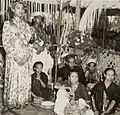 Coronation of the Raja of Gowa
Coronation of the Raja of Gowa On October 15, 1946 seven tribe rulers signed the Brief Declaration in front of the resident of South Sulawesi Lion Cachet
On October 15, 1946 seven tribe rulers signed the Brief Declaration in front of the resident of South Sulawesi Lion Cachet
References
- Sewang, Ahmad M. (2005). Islamisasi Kerajaan Gowa: abad XVI sampai abad XVII (in Indonesian). Yayasan Obor Indonesia. ISBN 978-9-794615300.
- "MAKASSAR". Retrieved March 4, 2016.
- Hannapia, Muhammad Ali (2012). "Masuknya Islam di Gowa". Universitas Hasanuddin (in Indonesian).
- Hefner, Robert W.; Horvatich, Patricia (1997). Robert W. Hefner; Patricia Horvatich (eds.). Islam in an Era of Nation-States: Politics and Religious Renewal in Muslim Southeast Asia. University of Hawaii Press. ISBN 978-0-824819576.
- Ricklefs, M.C. (2008). A History of Modern Indonesia Since C.1200 (revised ed.). Palgrave Macmillan. ISBN 978-1-137052018.
- Backshall, Stephen (2003). Rough Guide Indonesia (illustrated ed.). Singapore: Rough Guides. ISBN 978-1-858289915.
- National Centennial Commission (Philippines) (1998). Elmer A. Ordoñez (ed.). Toward the first Asian republic: papers from the Jakarta International Conference on the Centenary of the Philippine Revolution and the First Asian Republic. Philippine Centennial Commission. ISBN 9789719201830.CS1 maint: uses authors parameter (link)
- Esteban, Ivie Carbon (2010). "The Narrative of War in Makassar: Its Ambiguities and Contradictions". Sari - International Journal of the Malay World and Civilisation.
- Andaya, Leonard Y. (2013). The Heritage of Arung Palakka: A History of South Sulawesi (Celebes) in the Seventeenth Century. Volume 91 of Verhandelingen van het Koninklijk Instituut voor Taal-, Land- en Volkenkunde (illustrated ed.). Springer Science & Business Media. ISBN 978-9-401733472.
- Lach, Donald F.; Van Kley, Edwin J. (1998). Asia in the Making of Europe, Volume III: A Century of Advance. Book 3: Southeast Asia (illustrated, revised ed.). University of Chicago Press. ISBN 978-0-226467689.
- Cummings, William (2002). Making Blood White: Historical Transformations in Early Modern Makassar. University of Hawai'i Press. p. 257. ISBN 9780824825133.
- Watson, Noelle (2012). Asia and Oceania: International Dictionary of Historic Places. Routledge. p. 900. ISBN 9781136639791.
